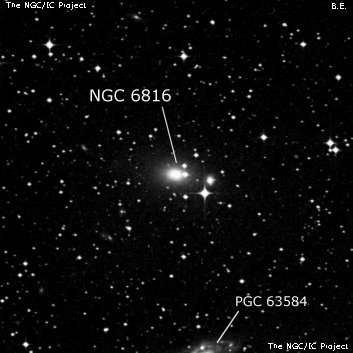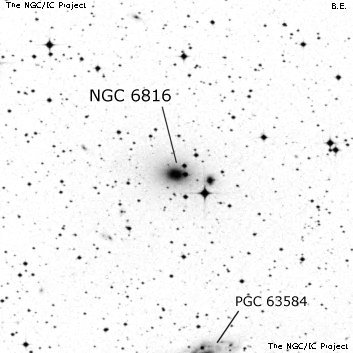NGC/IC Project Restoration Effort
(This is a very very beta version)
NGC6816


Basic Information
Location and Magnitude
Right Ascension: 19:44:2.4
Declination: -28:24:3
Constellation: SGR
Visual Magnitude: 12.9
Historic Information
Discoverer: Herschel J.
Year of discovery: 1834
Discovery aperture: 18.3
Observational
Summary description: eF, pS, R, vlbM, * np
Sub-type: E-S0
Corwin's Notes
=====
NGC 6816. RC3 is indeed wrong on this as it followed ESO and RNGC. SGC got
the wrong galaxy, too, and as Steve Gottlieb noted earlier, JH's original
description of the position of the star (six arcmin north) is correct.
Looking at GC, I see that the description is exactly the same as in NGC; it
does not follow the Cape of Good Hope description. So, the modification of
the description is due to John Herschel himself, not Dreyer. JH must have
done this to save space, though how he decided to place the star preceding as
well as north is a mystery to me. He also apparently mistook the nucleus of
ESO 460-G030 for one of the "vS stars" around the bright star 6' north.
Herbert Howe (1898, MN 58, 515) also has a curious observation of this object:
"In this is a star of mag 13.5. h noted a '* np.' I saw only a star of mag
14 at an angle of 20 degrees and a distance of 30 arcsec. The sky was dull,
so that the nebula was difficult to measure." I see his "star" of mag 13.5;
it looks like it is actually a superposed interacting galaxy. Howe also did
not publish his position; this means that he found that the original position
to be correct to within two arcmin. However, there are no stars 30 arcsec
away at PA = 20. There are stars at about this PA, but they are 14 arcsec and
55 arcsec away from the nucleus of the galaxy. I wonder if Howe somehow
picked up the wrong object. Well, whatever the case, while there are some
unsolved mysteries here, the identification of N6816 is clear.
Steve's Notes
=====
NGC 6816
24" (9/29/16): at 375x; fairly faint, elongated 5:3 WNW-ESE, ~40"x24", broad concentration with a brighter core. A faint star is off the NW edge [Note: there no star here but a compact companion is at the ESE end - probably my directions are reversed].
In a group with ESO 460-030 6' NNE. This galaxy (usually identified as NGC 6816) appeared fairly faint to moderately bright, small, round, 20"-24" diameter, very small bright nucleus, higher surface brightness than NGC 6816. Two mag 13.5-14.5 stars attached at the west edge interfere a bit and a mag 10.8 star is 1' SW. ESO 460-025, 15' W, appeared fairly faint, fairly small, slightly elongated, ~30"x25", broad weak concentration. A mag 11.5 star is 1.4' SE. ESO 460-033, 12' NE, appeared fairly faint, fairly small, elongated 4:3 WNW-ESE, moderate concentration to a small bright nucleus.
17.5" (6/8/91): very faint, fairly small, very low surface brightness. Forms an equilateral triangle with two mag 13 stars 2.8' SW and 2.8' SSE of center. A close mag 14.5 star is 1' NNE (?). Located 4.5' S of a mag 10.5 star.
Forms a pair with ESO 460-030 = MCG -05-46-006 6' NNE. ESO 460-030 is identified as NGC 6816 in RNGC, ESO, PGC, NED and HyperLeda. It appeared very faint, very small, round. Two mag 13.5 stars at the west and northwest edge confuse the observation as well as a mag 10.8 star 1' WSW that is detracting.



